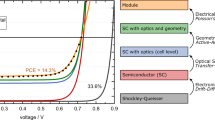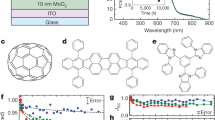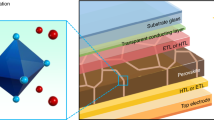Abstract
Thin-film and emerging technologies in photovoltaics (PV) offer advantages for lightweight, flexible power over the rigid silicon panels that dominate the present market. One important advantage is high specific power (the power-to-weight ratio). Here we consider niche market size, price points and value propositions that can provide a path for new PV market entrants. Examining the cost–production experience curves of Si, CdTe and CIGS PV suggests that a minimum market size of US$0.2–1 billion is required to incubate a new market entrant. Several markets requiring high specific power meet this threshold. We assess the critical role of the substrate, packaging and interconnects and provide a quantitative assessment of pathways to maximize specific power. With all requisite components included, along with requirements for safety and reliability, we estimate a lower bound for a durable lightweight module at about 300–500 g m−2. Pairing this bound with a 15%-efficiency thin-film or 35%-efficiency III–V module would yield specific powers up to 500 W kg−1 or 1,167 W kg−1, respectively.
This is a preview of subscription content, access via your institution
Access options
Access Nature and 54 other Nature Portfolio journals
Get Nature+, our best-value online-access subscription
$29.99 / 30 days
cancel any time
Subscribe to this journal
Receive 12 digital issues and online access to articles
$119.00 per year
only $9.92 per issue
Buy this article
- Purchase on Springer Link
- Instant access to full article PDF
Prices may be subject to local taxes which are calculated during checkout






Similar content being viewed by others
Data availability
The majority of data that support the plots presented in this paper and the calculated values presented in this study are available from the corresponding author upon reasonable request. The market data from SPV Market Research is the only exception. The corresponding author can provide contact information for SPV for the acquisition of those datasets.
References
Photovoltaic Manufacturer Shipments: Capacity, Price and Revenues 2016/2017 (SPV Market Research, 2017).
Reinhard, P. et al. Review of progress toward 20% efficiency flexible CIGS solar cells and manufacturing issues of solar modules. In 2012 IEEE 38th Photovoltaic Specialists Conference Part 2, 1–9 (IEEE, 2012).
Yang, M. et al. Highly efficient perovskite solar modules by scalable fabrication and interconnection optimization. ACS Energy Lett. 3, 322–328 (2018).
Kemp, R., Schot, J. & Hoogma, R. Regime shifts to sustainability through processes of niche formation: the approach of strategic niche management. Technol. Anal. Strategic Manage. 10, 175–198 (1998).
Mourik, R. & Raven, R. A Practitioner’s View on Strategic Niche Management Report ECN-E–06-039 (Energy Research Centre of the Netherlands, 2006).
Strupeit, L. & Palm, A. Overcoming barriers to renewable energy diffusion: business models for customer-sited solar photovoltaics in Japan, Germany and the United States. J. Cleaner Prod. 123, 124–136 (2016).
Song, Z. et al. A technoeconomic analysis of perovskite solar module manufacturing with low-cost materials and techniques. Energy Environ. Sci. 10, 1297–1305 (2017).
Solar Sheets, http://mldevices.com/index.php/product-services/photovoltaics (Microlink Devices, 2017).
Terrestrial Photovoltaic (PV) Modules – Design Qualification and Type Approval – Part 2: Test Procedures edn 1.0, IEC 61215-2 (IEC, Geneva, 2016).
Chirila, A. et al. Potassium-induced surface modification of Cu(In,Ga)Se2 thin films for high-efficiency solar cells. Nat. Mater. 12, 1107 (2013).
Chirila, A. et al. Highly efficient Cu(In,Ga)Se2 solar cells grown on flexible polymer films. Nat. Mater. 10, 857 (2011).
Measurement Procedures for Materials Used in Photovoltaic Modules — Part 2: Polymeric Materials — Frontsheets and Backsheets edn 1.0, IEC 62788-2 (IEC, Geneva, 2017).
Coyle, D. J. Life prediction for CIGS solar modules. Part 1: Modeling moisture ingress and degradation. Prog. Photovolt. Res. Appl. 21, 156–172 (2013).
Coyle, D. J. et al. Life prediction for CIGS solar modules. Part 2: Degradation kinetics, accelerated testing, and encapsulant effects. Prog. Photovolt. Res. Appl. 21, 173–186 (2013).
Coyle, D. J., Blaydes, H. A., Pickett, J. E., Northey, R. S. & Gardner, J. O. Degradation kinetics of CIGS solar cells. In 2009 34th IEEE Photovoltaic Specialists Conference 001943-001947 (IEEE, 2009).
Weerasinghe, H. C., Watkins, S. E., Duffy, N., Jones, D. J. & Scully, A. D. Influence of moisture out-gassing from encapsulant materials on the lifetime of organic solar cells. Sol. Energy Mater. Sol. Cells 132, 485–491 (2015).
Domanski, K., Alharbi, E. A., Hagfeldt, A., Grätzel, M. & Tress, W. Systematic investigation of the impact of operation conditions on the degradation behaviour of perovskite solar cells. Nat. Energy 3, 61–67 (2018).
Kempe, M. D., Panchagade, D., Reese, M. O. & Dameron, A. A. Modeling moisture ingress through polyisobutylene‐based edge‐seals. Prog. Photovolt. Res. Appl. 23, 570–581 (2015).
Kempe, M. D., Dameron, A. A. & Reese, M. O. Evaluation of moisture ingress from the perimeter of photovoltaic modules. Prog. Photovolt. Res. Appl. 22, 1159–1171 (2014).
Reese, M. O., Dameron, A. A. & Kempe, M. D. Quantitative calcium resistivity based method for accurate and scalable water vapor transmission rate measurement. Rev. Sci. Instrum. 82, 085101 (2011).
Fischer, T. Beyond The Panel Workshop Presentation (National Renewable Energy Lab, 2016).
Cuddihy, E. & Willis, P. B. Antisoiling Technology: Theories Of Surface Soiling And Performance Of Antisoiling Surface Coatings 19850007987, 85N16296 (NASA, 1984); https://ntrs.nasa.gov/archive/nasa/casi.ntrs.nasa.gov/19850007987.pdf
Peng, C.-Y. et al. Flexible CZTS solar cells on flexible Corning® Willow® Glass substrates. In 2014 40th Photovoltaic Specialist Conference, https://doi.org/10.1109/PVSC.2014.6924945 (IEEE, 2014).
Myong, S. Y. & Kwon, S. W. Superstrate type flexible thin-film Si solar cells using flexible glass substrates. Thin Solid Films. 550, 705–709 (2014).
Tavakoli, M. M. et al. Highly efficient flexible perovskite solar cells with antireflection and self-cleaning nanostructures. ACS Nano. 9, 10287–10295 (2015).
Sheehan, S. et al. Flexible glass substrate based dye sensitized solar cells. Sol. Energy Mater. Sol. Cells 132, 237–244 (2015).
Mahabaduge, H. et al. High-efficiency, flexible CdTe solar cells on ultra-thin glass substrates. Appl. Phys. Lett. 106, 133501 (2015).
Cambone, S. A., Krieg, K. J., Pace, P. & Linton, W. Unmanned Aircraft Systems Roadmap 2005-2030 (Office of the Secretary of Defense, 2005); https://fas.org/irp/program/collect/uav_roadmap2005.pdf
CEOS EO Handbook-Catalogue of Satellite Missions database.eohandbook.com/database/missiontable.aspx (CEOS, 2018).
Single Predator B RPA Amasses 20,000 Flight Hours (General Atomics Aeronautical, 2015).
Predator-Series Aircraft Pass Five Million Flight Hour Mark, http://www.ga-asi.com/predator-series-aircraft-pass-five-million-flight-hour-mark (General Atomics Aeronautical, 2018).
Horowitz, K. A., Woodhouse, M., Lee, H., & Smestad, G. P. A bottom-up cost analysis of a high concentration PV module. In AIP Conference Proceedings, https://doi.org/10.1063/1.4931548 (AIP, 2015).
Wesoff, E. Alta Devices, GaAs Solar Startup, Finally Admits Acquisition by China’s Hanergy, https://www.greentechmedia.com/articles/read/alta-devices-gaas-solar-startup-finally-admits-acquisiition-by-chinas-ha (GreenTechMedia, 2014).
Top 8 Solar Powered Drone (UAV) Developing Companies, http://sinovoltaics.com/technology/top8-leading-companies-developing-solar-powered-drone-uav-technology/ (Dricus, 2015).
Shields, E. Needs Beyond The Panel, https://doi.org/10.6084/m9.figshare.7025759 (Figshare, 2014).
Sunlinq Portable Solar Charger 3 & 4, https://p3solar.com/wp-content/uploads/2015/08/Sunlinq-3-4-Instruction-Sheet-040915.pdf (P3 Solar, 2015).
PowerFilm, Inc. Limited Product Warranty, https://www.powerfilmsolar.com/contact-us/warranty/ (Powerfilm Solar, 2018).
Fm16-7200 120W Foldable Solar Panel, http://www.powerfilmsolar.com/products/?fm167200_120w_foldable_solar_panel&show=product&productID=271514&productCategoryIDs=6578,6579 (Powerfilm, 2017).
75W 24V Portable Solar Charger Spec Sheet, http://p3solar.com/portfolio/p3-75w-24v-portable-solar-charger2/ (P3 Solar, 2017).
21W Rollable Solar Charger Spec Sheet, http://p3solar.com/portfolio/p3-21w-rollable-solar-charger/ (P3 Solar, 2017).
Cristiani, J. in Alternative Energy for Defense Conference, http://www.dtic.mil/dtic/tr/fulltext/u2/a562519.pdf (Power Generation and Alternative Energy Branch, US Army Power Division, 2011).
Abdelhamid, M., Haque, I., Pilla, S., Filipi, Z. S. & Singh, R. Impacts of adding photovoltaic solar system on-board to internal combustion engine vehicles towards meeting 2025 fuel economy CAFE standards. SAE Int. J. Alternative Powertrains, https://doi.org/10.4271/2016-01-1165 (2016).
New York Presentation: The Emerging Giant of Graphite Supply into the Renewable Energy Industry http://www.syrahresources.com.au/investors/downloads/406 (Syrah Resources, 2016).
King, D. The Toyota Prius’s Roof-mounted Solar Panel Isn’t Coming to the US https://www.autoblog.com/2016/06/17/toyota-prius-plug-in-solar-roof-us/ (Autoblog, 2016).
Outlook 2016 Beyond One Million Electric Cars, https://www.iea.org/publications/freepublications/publication/Global_EV_Outlook_2016.pdf (OECD/IEA, 2016).
Global EV Outlook 2017 Two Million And Counting, https://www.iea.org/publications/freepublications/publication/GlobalEVOutlook2017.pdf (OECD/IEA, 2017).
Price List Effective From August 1st 2017, https://www.toyota.co.uk/world-of-toyota/price-list.json (Toyota, 2017).
Electric Vehicles To Be 35% Of Global New Car Sales By 2040, https://about.bnef.com/blog/electric-vehicles-to-be-35-of-global-new-car-sales-by-2040/ (Bloomberg New Energy Finance, 2016).
Offgrid Solar Market Trends Report, http://www.lightingglobal.org/wp-content/uploads/2016/03/20160301_OffGridSolarTrendsReport-1.pdf (Lighting Global, World Bank Group, 2016).
Nokero N233 Solar Light, https://www.nokero.com/Solar-Light-N233-p/n233.htm (Nokero Solar USA LLC, 2018).
Customized Solar Cells http://gcell.com/gcell-products/custom-solar-cell (Gcell, 2018).
Solo Bucket Spec Sheet, http://solopower.com/wp-content/uploads/Solo-Bucket-Spec-Sheet-21-Sep1.pdf (Solopower Systems, 2018).
Mints, P. Overview of photovoltaic production, markets, and perspectives. In Semiconductors and Semimetals Vol. 87, 49–84 (Elsevier, 2012).
Apostolou, G., Reinders, A. & Verwaal, M. Comparison of the indoor performance of 12 commercial PV products by a simple model. Energy Sci. Eng. 4, 69–85 (2016).
De Rossi, F., Pontecorvo, T. & Brown, T. M. Characterization of photovoltaic devices for indoor light harvesting and customization of flexible dye solar cells to deliver superior efficiency under artificial lighting. Appl. Energy 156, 413–422 (2015).
Matiko, J., Grabham, N., Beeby, S. & Tudor, M. Review of the application of energy harvesting in buildings. Meas. Sci. Technol. 25, 012002 (2013).
Snow, M. Understanding BIPV-T and Market Trends, http://tractile.com.au/wp-content/uploads/2015/05/literature-to-support-tractile12.pdf (Tractile, 2015).
BIPV Market Analysis By Technology (Crystalline Silicon, Thin Film) By Application (Roofs, Walls, Glass Integrated, Facade), By End-Use (Residential, Commercial, Industrial), By Region (North America, Europe, Asia Pacific), And Segment Forecasts, 2013–2024 (Grand View Research, 2016).
Building Integrated Photovoltaics Market: Global Industry Analysis, Size, Share, Growth, Trends and Forecast, 2013–2019 (Transparency Market Research, 2015).
BIPV Technologies and Markets, 2015–2022 (Nanomarkets, 2015).
Report on CIGS and CdTe Market History (SPV Market Research, 2017).
Margolis, R., Feldman, D. & Boff, D. Q4 2016/Q1 2017 Solar Industry Update 1358147 (National Renewable Energy Laboratory, 2017).
Cost Effective IC Manufacturing: 1998–1999 (Integrated Circuit Engineering Corporation, 1997).
Munoz, L. H., Huijben, J. C., Verhees, B. & Verbong, G. P. The power of grid parity: a discursive approach. Technol. Forecast. Soc. Change 87, 179–190 (2014).
Series 4 Module Datasheet, http://www.firstsolar.com/-/media/First-Solar/Technical-Documents/Series-4-Datasheets/Series-4-Module-Datasheet---V3-103116-%281%29.ashx (First Solar, 2016).
InfinityPV Panels, https://www.infinitypv.com/products/panels (Infinity PV, 2017).
Link Solar Catalog 2016, http://www.flexible-solar-panel.com/flexible-solar-panel (Link Solar, 2016).
138W Panel, http://www.sbmsolar.com/home/sbm_solar-138WPanel.php (SBM Solar, 2017).
Product Data Sheet SF175-S, http://www.solar-frontier.com/eng/solutions/products/pdf/datesheat_175.pdf (Solar Frontier, 2017).
SunPower Z-Series Residential Solar Panels, https://us.sunpower.com/sites/sunpower/files/media-library/data-sheets/ds-x21-series-335-345-residential-solar-panels.pdf (SunPower, 2016).
The Allmax Framed 60-cell Module, http://static.trinasolar.com/sites/default/files/PS-M-0323 E Datasheet_Allmax_US_Feb_2017_A_0.pdf (Trina Solar, 2017).
XLS Data Sheet, http://www.xunlightchina.com/Download/cpgg.aspx (Xunlight, 2017).
Edmondson, K. M. et al. Flexible III-V multijunction solar blanket. In 2006 IEEE 4th Photovoltaic Energy Conversion Conference, https://doi.org/10.1109/WCPEC.2006.279876 (IEEE, 2006).
Romeo, A. et al. High-efficiency flexible CdTe solar cells on polymer substrates. Sol. Energy Mater. Sol. Cells 90, 3407–3415 (2006).
Guha, S. et al. Ultra lightweight photovoltaic device and method for its manufacture. US patent US7517465B2 (2009)
Shiu, K.-T., Zimmerman, J., Wang, H. & Forrest, S. R. Ultrathin film, high specific power InP solar cells on flexible plastic substrates. Appl. Phys. Lett. 95, 223503 (2009).
Banerjee, A. et al. Advances in cell efficiency of a-Si:H and nc-Si:H-based multi-junction solar cells for space and near-space applications. In 2010 35th IEEE Photovoltaic Specialists Conference, https://doi.org/10.1109/PVSC.2010.5617209 (IEEE, 2010)
Kaltenbrunner, M. et al. Flexible high power-per-weight perovskite solar cells with chromium oxide-metal contacts for improved stability in air. Nat. Mater. 14, 1032–1039 (2015).
Haynes, W. M. CRC Handbook of Chemistry and Physics 97th edn (CRC Press, 2016).
Mark, J. E. Polymer Data Handbook (Oxford Univ. Press, 2009).
DuPont Tedlar Polyvinyl Fluoride (PVF) Films, http://www.dupont.com/content/dam/dupont/products-and-services/membranes-and-films/pvf-films/documents/DEC_Tedlar_GeneralProperties.pdf (Dupont, 2014).
Corningwillow Glass Fact Sheet, https://www.corning.com/media/worldwide/cdt/documents/Willow_2014_fact_sheet.pdf (Corning, 2016).
DuPont Elvax EVA Resins for Adhesives, Sealants and Wax Blends, http://www.dupont.com/content/dam/dupont/products-and-services/membranes-and-films/pvf-films/documents/DEC_Tedlar_GeneralProperties.pdf (Dupont, 2012).
Photovoltaic (PV) Module Safety Qualification—Part 1: Requirements For Construction. 2nd edn, IEC 61730-1 (IEC, 2016).
National Electrical Code - Solar Photovoltaic (PV) Systems 70-Article 690 (National Fire Protection Association, 2014).
Green, M. A. et al. Solar cell efficiency tables (version 50). Prog. Photovolt. Res. Appl. 25, 668–676 (2017).
Technology Perfomance Brief, http://www.altadevices.com/wp-content/uploads/2016/12/technology-performance-brief-1216.pdf (Alta Devices, 2016).
Copper Indium Gallium Selenide/CIGS (CuIn x Ga (1-x) Se 2 ) Semiconductors, https://www.azom.com/article.aspx?ArticleID=8432 (AZO Materials, 2013).
AZO—Aluminium Oxide + Zinc Oxide, http://www.china-raremetal.com/product/aluminum_oxide_zinc oxide_azo.htm (China Rare Metal, 2010).
Custer, J. et al. Density of amorphous Si. Appl. Phys. Lett. 64, 437–439 (1994).
Acknowledgements
We thank A. Hicks for his assistance in making the graphics more appealing and C. Wolden for insight into the discussions and structure of the manuscript. This work was supported by the US Department of Energy under contract number DE-AC36-08-GO28308 with Alliance for Sustainable Energy, LLC, manager and operator of the National Renewable Energy Laboratory (NREL). Funding was provided by the US Office of Naval Research as well as through the Lab Directed Research and Development (LDRD) program at NREL. The views expressed in the article do not necessarily represent the views of the DOE or the US Government.
Author information
Authors and Affiliations
Contributions
M.O.R., T.M.B. and N.M.H. posed the initial research questions and framed the analysis. M.O.R., S.G. and S.B. performed strategic niche market analysis. M.O.R., S.G., D.F. and N.M.H. performed the historical market analysis. M.O.R., S.G., D.L.M., T.M.B. and N.M.H. analysed the state-of-the-art high-specific-power PV market. M.O.R., S.G., D.L.M. and M.D.K. bounded, described and provided examples of the elements of PV packaging. M.O.R., S.G., D.L.M. and M.S.D. calculated the effects of interconnects. M.O.R., S.G., M.D.K. and N.M.H. led the writing of the manuscript with all other authors contributing.
Corresponding author
Ethics declarations
Competing interests
The authors declare no competing interests.
Additional information
Publisher’s note: Springer Nature remains neutral with regard to jurisdictional claims in published maps and institutional affiliations.
Supplementary information
Supplementary Data 1
Details of the technology, efficiency, specific power and references used to produce Fig. 3
Rights and permissions
About this article
Cite this article
Reese, M.O., Glynn, S., Kempe, M.D. et al. Increasing markets and decreasing package weight for high-specific-power photovoltaics. Nat Energy 3, 1002–1012 (2018). https://doi.org/10.1038/s41560-018-0258-1
Received:
Accepted:
Published:
Issue Date:
DOI: https://doi.org/10.1038/s41560-018-0258-1
This article is cited by
-
The first demonstration of entirely roll-to-roll fabricated perovskite solar cell modules under ambient room conditions
Nature Communications (2024)
-
Efficiency limit of transition metal dichalcogenide solar cells
Communications Physics (2023)
-
Investigation of Ag(Ga,In)Se2 as thin-film solar cell absorbers: A first-principles study
Science China Physics, Mechanics & Astronomy (2022)
-
Bioinspired antireflective flexible films with optimized mechanical resistance fabricated by roll to roll thermal nanoimprint
Scientific Reports (2021)
-
High-specific-power flexible transition metal dichalcogenide solar cells
Nature Communications (2021)



